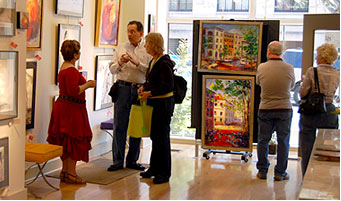Downtown Lancaster

A hub of art, culture, shopping and dining, historic downtown Lancaster is a vibrant city packed with activities for locals and visitors alike – the heart of Lancaster County’s creative side. The city is situated in the center of Lancaster County, and its seven square miles are packed with art, museums, historical attractions, restaurants and cafes, theatres, shops and boutiques.
Strolling the city’s streets is the best way to experience its flavor. You’ll find the impressive work of local artists at dozens of galleries, such as those along Prince Street, affectionately dubbed “Gallery Row.” In fact, meet the artists during the “First Fridays” of the month, when many galleries extend their hours and host special receptions. The 300 block of North Queen Street, a restored shopping district, is home to a quirky, eclectic selection of antique stores, retro and collectible shops, glass studios and casual cafes. Art can also be found on many downtown buildings via a variety of hand-painted murals; check them out on the Downtown Lancaster Murals Trail.
The unique historical landmarks of Central Market and Fulton Theatre promise special experiences for visitors. Central Market, the country’s oldest continuously-operating farmers’ market, offers fresh produce, meats, cheeses, baked goods, flowers, craft and much more. Likewise, Fulton Theatre is the oldest continuously-operating theatre in the country and one of only three national historic landmark theatres. Lancaster has its fair share of haunted history as well which you can explore on a guided Lancaster Ghost Tour. Museums and historical attractions run the gamut in downtown Lancaster and offer a taste of local culture, art, science and the stories that shaped Lancaster’s past. See a sample of cultural spots at right.
It’s quite evident that downtown Lancaster’s charm is rooted in rich history. Established in 1730, the city began as a trading post in the wilderness, which also served as a frontier checkpoint for pioneers. During the 1800s, the city developed into an industrial powerhouse, feuled by accessible railroad transportation and the title of the second-largest tobacco seed leaf market in the United States. As a convenient location for east-west travel, Lancaster City served as Pennsylvania’s capital from 1799-1812 and at one time was considered for the nation’s capital. Today, it still maintains hundreds of historical landmarks, which contribute to it being the largest National Historic Register District in the country.

